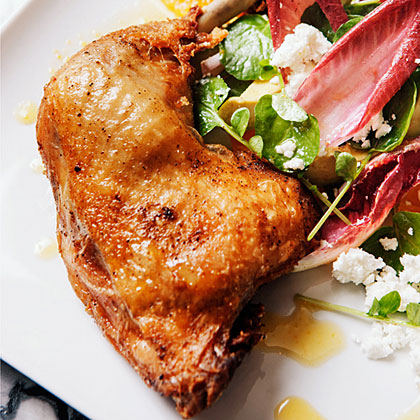Crisp Chicken Confit

Denver chef Jennifer Jasinski, a 2013 James Beard Award winner for best Southwest chef and a competitor on the fifth season of Top Chef Masters, is known for her bright, fresh cooking and for her inventive use of classic French technique. Making confit–the ultra-slow transformation of raw meat into rich, crisp-skinned succulence–ranks as one of her favorite methods, and it works for duck or rabbit too.
Jasinski prefers to use duck or chicken fat for the confit, but easier-to-find lard or a 50-50 blend of olive oil and vegetable oil also works. Olive oil on its own, however, has too strong a flavor, says Jasinski.
How to Make It
Pat chicken dry. “That helps the salt and pepper go on evenly.” Mix salt and pepper and sprinkle over chicken. Put in a 4- or 5-qt. dutch oven and arrange garlic and thyme sprigs on top. Cover and chill at least 12 hours and up to
Preheat oven to 200°. Add duck fat to chicken; warm on stovetop over lowest heat, covered, until fat is melted, about 20 minutes. It should completely cover chicken; if it doesn’t, add more. Bake until meat is very tender when pierced, at least 8 hours and up to
Using tongs, carefully transfer chicken to a 9- by 13-in. baking dish and chill. Wait for melted fat to cool, then ladle into containers and chill for future use. Leave behind the garlic and herbs at the bottom of the pot and any gelatinized meat juices too. If you don’t plan to use all the chicken right away, cover it with still-liquid fat; it will keep, covered in the refrigerator, for a few months. (In fact, in the old days, cooks kept it at cool room temperature for weeks.) “You can use the fat to cook. The next time you make a roast chicken, instead of olive oil, put this fat on it. Or brush it on grilled bread.”
To use confit, crisp it up: Spoon cooking fat into a deep, wide pan. If chicken has been chilled in fat, transfer to a baking sheet and scrape off fat.
Heat fat over medium heat until it reaches between 275° and 300° on a deep-fry thermometer. Add chicken legs, skin side down. “If they don’t really sizzle, the fat isn’t hot enough. Also, cold chicken legs are going to drop the temperature of your fat, so crank up the heat to around 350°.”
Cook, adjusting heat to keep temperature between 275° and 300°, until chicken is lightly browned and crisp, 10 to 12 minutes, turning once. “Focus on getting a nice crisp skin on the chicken, not just on the time it takes.” Using tongs (and a slotted spoon if you need it, to help hold the very tender, delicate chicken together), transfer chicken to a rack set over a rimmed baking sheet to drain. It’s now ready to eat.
*Find these fats at some butcher shops and at well-stocked grocery stores.
Note: Nutritional analysis is per whole leg
Ingredients
Directions
Pat chicken dry. “That helps the salt and pepper go on evenly.” Mix salt and pepper and sprinkle over chicken. Put in a 4- or 5-qt. dutch oven and arrange garlic and thyme sprigs on top. Cover and chill at least 12 hours and up to
Preheat oven to 200°. Add duck fat to chicken; warm on stovetop over lowest heat, covered, until fat is melted, about 20 minutes. It should completely cover chicken; if it doesn’t, add more. Bake until meat is very tender when pierced, at least 8 hours and up to
Using tongs, carefully transfer chicken to a 9- by 13-in. baking dish and chill. Wait for melted fat to cool, then ladle into containers and chill for future use. Leave behind the garlic and herbs at the bottom of the pot and any gelatinized meat juices too. If you don’t plan to use all the chicken right away, cover it with still-liquid fat; it will keep, covered in the refrigerator, for a few months. (In fact, in the old days, cooks kept it at cool room temperature for weeks.) “You can use the fat to cook. The next time you make a roast chicken, instead of olive oil, put this fat on it. Or brush it on grilled bread.”
To use confit, crisp it up: Spoon cooking fat into a deep, wide pan. If chicken has been chilled in fat, transfer to a baking sheet and scrape off fat.
Heat fat over medium heat until it reaches between 275° and 300° on a deep-fry thermometer. Add chicken legs, skin side down. “If they don’t really sizzle, the fat isn’t hot enough. Also, cold chicken legs are going to drop the temperature of your fat, so crank up the heat to around 350°.”
Cook, adjusting heat to keep temperature between 275° and 300°, until chicken is lightly browned and crisp, 10 to 12 minutes, turning once. “Focus on getting a nice crisp skin on the chicken, not just on the time it takes.” Using tongs (and a slotted spoon if you need it, to help hold the very tender, delicate chicken together), transfer chicken to a rack set over a rimmed baking sheet to drain. It’s now ready to eat.
*Find these fats at some butcher shops and at well-stocked grocery stores.
Note: Nutritional analysis is per whole leg

